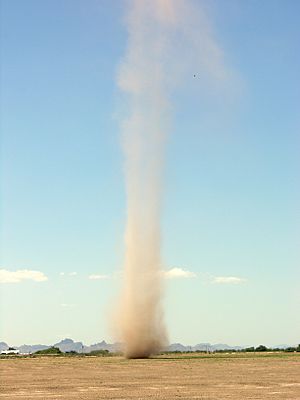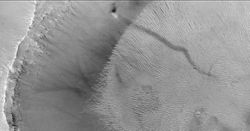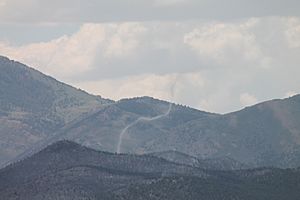Dust devil facts for kids
Quick facts for kids Dust devil |
|
|---|---|

A dust devil in Arizona.
|
|
| Area of occurrence | Primarily temperate and tropical regions. |
| Season | Most common in summer. |
| Effect | Dust and debris lofted into air, possibly wind damage. |
Dust devils are twirling masses of air that form in the desert and send sand spinning. The height of a dust devil can range from a few meters tall to more than 1,000 meters (3,281 ft) tall. They are usually harmless, but occasionally they can cause some damage to both people and property.
Contents
Formation
A dust devil forms when hot air near the ground rises quickly through a small pocket of cooler, low-pressure air above it. If conditions are just right, then the air may begin to rotate. As the air rapidly rises, the hot air is stretched vertically and because of angular momentum, the spinning gets much more intense. Because the hot air cools when it rises, it eventually goes down to the base and expands horizontally, while more hot air shoots up the column to replace the lost air. The air that is displaced falls to the ground around the dust devil, creating a balancing force. Thus, a dust devil is formed.
Certain conditions help the formation of dust devils:
1. Flat barren, desert terrain: Flat terrain and hot conditions help the hot air "fuel" being always available. The dust and sand helps the dust devil be seen.
2. Clear skies or lightly cloudy conditions: The surface needs a lot of solar energy to heat the air.
3. Light or no wind, and cool temperature in the atmosphere: Without a cool atmosphere and hot surface, the dust devil with never form. Wind will not keep the dust devil stable.
A dust devil "dies" when it eventually sucks in cool air from the surface. Cool air destroys the dust devil because it quickly discourages the rising of air through the column. This usually happens when the dust devil becomes weak, or moves across a new terrain were the surface temperatures are cooler.
Intensity and duration
On Earth, many dust devils are usually small and weak, often less than 3 feet (0.9 m) in diameter with maximum winds averaging about 45 miles per hour (70 km/h), and they often dissipate less than a minute after forming. On rare occasions, a dust devil can grow very large and intense, sometimes reaching a diameter of up to 300 feet (90 m) with winds in excess of 60 mph (100 km/h+) and can last for upwards of 20 minutes before dissipating.
Hazards
Dust devils typically do not cause injuries, but rare, severe dust devils have caused damage and even deaths in the past. One such dust devil struck the Coconino County Fairgrounds in Flagstaff, Arizona, on September 14, 2000, causing extensive damage to several temporary tents, stands and booths, as well as some permanent fairgrounds structures. Several injuries were reported, but there were no fatalities. Based on the degree of damage left behind, it is estimated that the dust devil produced winds as high as 75 mph (120 km/h), which is equivalent to an EF-0 tornado. On May 19, 2003, a dust devil lifted the roof off a two-story building in Lebanon, Maine, causing it to collapse and kill a man inside. In East El Paso, Texas in 2010, three children in an inflatable jump house were picked up by a dust devil and lifted over 10 feet (3 m), traveling over a fence and landing in a backyard three houses away. In Commerce City, Colorado in 2018, a powerful dust devil hurtled two porta-potties into the air. No one was injured in the incident. In 2019 a large dust devil in Yucheng county, Henan province, China killed 2 children and injured 18 children and 2 adults when a bouncy castle was lifted into the air.
Dust devils have been implicated in around 100 aircraft accidents. While many incidents have been simple taxiing problems, a few have had fatal consequences. Dust devils are also considered major hazards among skydivers and paragliding pilots as they can cause a parachute or a paraglider to collapse with little to no warning, at altitudes considered too low to cut away, and contribute to the serious injury or death of parachutists.
Electrical activities
Dust devils, even small ones (on Earth), can produce radio noise and electrical fields greater than 10,000 volts per meter. A dust devil picks up small dirt and dust particles. As the particles whirl around, they become electrically charged through contact or frictional charging (triboelectrification). The whirling charged particles also create a magnetic field that fluctuates between 3 and 30 times each second.
These electric fields may assist the vortices in lifting material off the ground and into the atmosphere. Field experiments indicate that a dust devil can lift 1 gram of dust per second from each square metre (10 lb/s from each acre) of ground over which it passes. A large dust devil measuring about 100 metres (330 ft) across at its base can lift about 15 metric tonnes (17 short tons) of dust into the air in 30 minutes. Giant dust storms that sweep across the world's deserts contribute 8% of the mineral dust in the atmosphere each year during the handful of storms that occur. In comparison, the significantly smaller dust devils that twist across the deserts during the summer lift about three times as much dust, thus having a greater combined impact on the dust content of the atmosphere. When this occurs, they are often called sand pillars.
Martian dust devils
Dust devils also occur on Mars (see dust devil tracks) and were first photographed by the Viking orbiters in the 1970s. In 1997, the Mars Pathfinder lander detected a dust devil passing over it. In the first image below, photographed by the Mars Global Surveyor, the long dark streak is formed by a moving swirling column of Martian atmosphere. The dust devil itself (the black spot) is climbing the crater wall. The streaks on the right are sand dunes on the crater floor.
Martian dust devils can be up to fifty times as wide and ten times as high as terrestrial dust devils, and large ones may pose a threat to terrestrial technology sent to Mars. On 7 November 2016, five such dust devils ranging in heights of 0.5 to 1.9 km were imaged in a single observation by Mars Orbiter Mission in martian southern hemisphere.
Mission members monitoring the Spirit rover on Mars reported on March 12, 2005, that a lucky encounter with a dust devil had cleaned the solar panels of that robot. Power levels dramatically increased and daily science work was anticipated to be expanded. A similar phenomenon (solar panels mysteriously cleaned of accumulated dust) had previously been observed with the Opportunity rover, and dust devils had also been suspected as the cause. The electrical activity associated with dust devils is widely thought to generate lightning on Mars, but this has not yet been conclusively detected.
Alternate names
In Australia, a Dust Devil is also known as "Willy-willy".
In Ireland, Dust Devils are known as "Shee-gaoithe" or "Fairy wind"
Related phenomena


Fire whirls or swirls, sometimes called fire devils or fire tornadoes, can be seen during intense fires in combustible building structures or, more commonly, in forest or bush fires. A fire whirl is a vortex-shaped formation of burning gases being released from the combustible material. The genesis of the vortex is probably similar to that of a dust devil. As distinct from the dust devil, it is improbable that the height reached by the fire gas vortex is greater than the visible height of the vertical flames because of turbulence in the surrounding gases that inhibit creation of a stable boundary layer between the rotating/rising gases relative to the surrounding gases.
Hot cinders underneath freshly deposited ash in recently burned areas may sometimes generate numerous dust devils. The lighter weight and the darker color of the ash may create dust devils that are visible hundreds of feet into the air.
Ash devils form similar to dust devils and are often seen on unstable days in burn scar areas of recent fires.
Steam devils are phenomena often observed in the steam rising from power plants.
The same conditions can produce a snow whirlwind, although differential heating is more difficult in snow-covered areas.
Coal devils are common at the coal town of Tsagaan Khad in South Gobi Province, Mongolia. They occur when dust devils pick up large amounts of stockpiled coal. Their dark color makes them resemble some tornadoes.
Related pages
See also
 In Spanish: Remolino de arena para niños
In Spanish: Remolino de arena para niños










